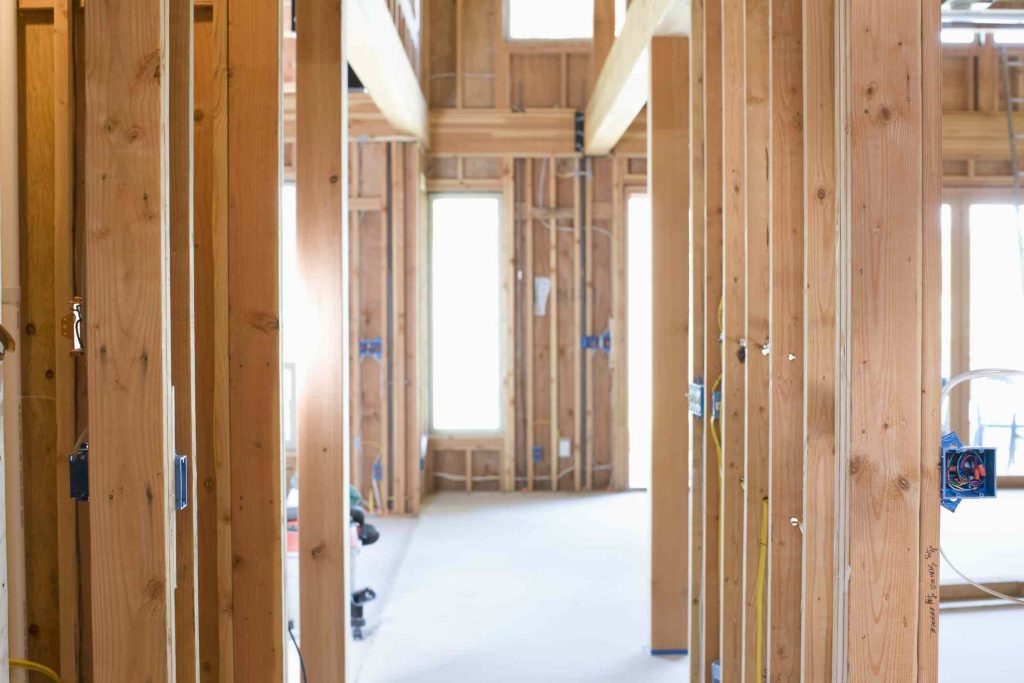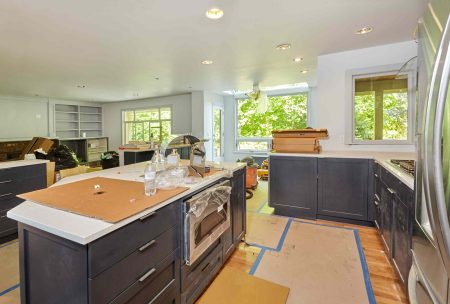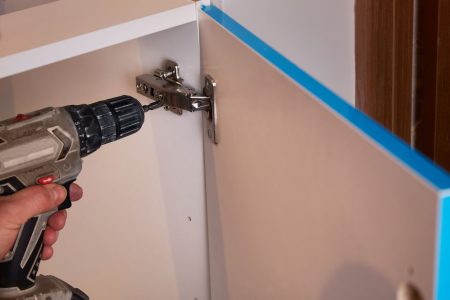In the home building and remodeling trades, particularly plumbing and electrical, the term rough-in refers to a critical early stage after basic services have been installed but before they are complete. Specifically, rough-in plumbing is the initial process of installing water supply lines, drain lines, vents, and pipeline connections. Once this basic infrastructure is in place and has been approved by a building inspector, plumbing professionals can move onto the finish plumbing phase.
While rough-in plumbing is a term that is frequently used by plumbing professionals, it can also be referenced on building layouts or blueprints. If you are considering purchasing a new home and notice that an unfinished area of the basement is noted as having rough-in plumbing, this means that the water lines, drain lines, and vent lines have been installed for a basement kitchen or bathroom. Find out more about what rough-in plumbing is and how to work with rough-in plumbing.
What Rough-in Plumbing Is
Rough-in plumbing is the process of installing vents, sewage systems, connections and water supply lines. In a more general sense, rough-in can refer to the stage of construction after the basic framing is complete and the initial services, such as wiring or pipes, have been installed, but their end-points, like outlets or fixtures, have not been installed.
During the rough-in stage, the excavation and laying of underground pipes running from the utility connections to the main structure is completed. The pipes are then routed through wall cavities, the vents stacks are run to the roof, drain lines are connected to the sewer system or septic system, water lines are connected to the main water supply valve, and pipeline connections are made. Upon completion of the rough-in phase, you can start the finish plumbing phase.
Rough-in vs. Finish Plumbing
The initial stage of installing plumbing infrastructure in a new home is known as rough-in plumbing, while finish plumbing is the next step in the process when the plumber begins installing faucets, under sink drain assemblies, water system valves, and other fixtures.
- Rough-in plumbing is generally handled by a professional plumber with training, knowledge, and experience with this work. During this stage of construction the plumber is responsible for excavating the yard to run underground water and drain lines from the utility connections to the main structure. The plumber will also drill holes for water lines, drain lines, and vent stacks where appropriate throughout the home. After drilling the holes, the plumber will run water pipes, drain lines, and vent stacks through the wall cavities, making pipeline connections as necessary.
- Finish plumbing follows after the completion of the rough-in plumbing stage. Some experienced DIYers may be able to handle the finish plumbing stage, but for the best results, it’s recommended to hire a professional plumber. During this phase of the project, any caps on drain and water supply lines are removed and the installation of plumbing fixtures is completed. The plumber will also set up under sink drain assemblies, install water system valves, and test any connections for leaks.
How to Do Rough-in Plumbing
Completing rough-in plumbing on your own for a new home is not recommended unless you have professional experience and are up to date on building code and inspection requirements. However, if you are installing rough-in plumbing for a new bathroom, kitchen, or laundry room in an existing home, you may be able to handle a portion of the work, depending on your knowledge, experience, and skill. Just keep in mind that rough-in work should be inspected before moving onto finish plumbing.
When you are tackling rough-in plumbing there are several crucial factors to consider. Gravity is a key component of any drainage system, so drain lines need to be positioned in such a way that they angle downward. Avoid long horizontal drain line runs as much as possible. Additionally, you need to ensure that the wastewater system is properly vented to avoid future issues with the home plumbing infrastructure.
-
Excavate and Lay Main Water and Drain Lines
Rough-in plumbing typically starts by excavating the area required to run water lines and drain lines from the utility connections to the main building. With the area excavated, you can either complete the connections yourself if you have the experience, or hire a plumber to run the main water line and main drain line from the utility connections to the building.
-
Measure and Drill Tub and Toilet Drains
After the main water and main drain lines are installed, you can focus on the bathrooms. Set and level each tub so you can mark where the drain will go, then remove the tub and drill the hole for the drain. Make sure that you are not positioned over a floor joist before drilling the hole.
Once you cut the holes, reposition the tub and set it will two-inch screws. While you are in the bathroom, measure and mark the position for the toilet. In general, it should sit about 13 inches off the back wall and a minimum of 15 inches from the tub. Use a hole saw to drill out the hole for the toilet drain.
-
Drill Holes for Drainage and Venting
The next step in the process is to use a hole saw to drill holes to route drain lines and vent stacks through the wall cavities. Remember to factor in gravity when you are positioning drain lines so that you don’t inadvertently install long horizontal drain runs.
When gluing drain fittings together, use the application brush to liberally coat the pipe and the inside of the fitting. Push the pipe into the connection, then rotate left and right to ensure that there are no bare spots inside the glue joint. Wipe off any excess glue before it sets.
Vent stacks should extend from the basement through each floor of the home to the roof. This means that you will need to get into the attic to connect the appropriate vents and terminate them outside.
-
Drill Holes and Run Water Lines
With the drain and vent lines in place, you can start to install the water lines. Typically, it’s a good idea to run 3/4-inch pipes as close to where they are required for the bathroom, kitchen, or any water-using appliances, like the fridge, washing machine, or dishwasher. Then reduce the 3/4-inch water line to a 1/2-inch line for each individual fixture.
Ideally, the length of 1/2-inch pipe should be as short and straight as possible. You should also take the opportunity to drill holes to the exterior of the home for any hose bibs. Depending on your geographic location, it may be beneficial to angle the hose bib lines upwards to help prevent freezing during the winter months.
-
Externally Vent Plumbing Equipment
The rough-in stage also includes drilling vent holes for any additional plumbing equipment, including sump pumps, water heaters, and boilers. Double-check the blueprints to determine where the plumbing equipment will be installed in the home, then drill out the holes for external venting.
-
Complete Water, Drain, and Vent Tie-Ins
At this point in the process you can run the primary hot and cold water lines in the basement, drop the main three-inch drain stack, and run the central vent stack. Next, start connecting any cold and hot water lines to the primary water lines, then tie-in the various drain lines to the main three-inch drain stack.
Connect the vent lines to the central vent stack and tie together the drain lines for any half baths. You should also ensure the hot and cold water lines run to where the water heater will be installed.
-
Connect and Test the Water Line
The last step of the rough-in process is to connect the water lines to the main incoming service and install a main shut-off valve. Make sure to cap or install isolation valve on any water lines that are currently open, then turn on the water to test the plumbing system for leaks. Rough-in plumbing is just the start of the installation process, so if you spot any issues, fix the problem now before drywall covers up the plumbing infrastructure.
-
How is rough-in plumbing done?
During the rough-in plumbing stage the plumber will excavate and lay water and drain lines from the utility connections to the building. They will then route the water lines, drain lines, and vent stacks through wall cavities in the home. Water lines are then connected to the main water supply valve, drain lines are connected to the sewer system or septic system, and vent stacks are run to the roof.
-
Is rough-in plumbing difficult?
Rough-in plumbing is essentially putting in the entire plumbing infrastructure for the home. It’s a complex process that takes time and experience to complete without issues. The best way to complete rough-in plumbing for your new home is to hire a professional plumber. It isn’t recommended to tackle rough-in plumbing work as a DIY project.
-
How long does it usually take to rough-in plumbing?
On average, an experienced professional plumbing crew can complete rough-in plumbing within a few days, but on an actual jobsite there may be delays that can increase the timeline to a few weeks. If you are concerned about the length of time, speak to your plumber to get an estimate and work with them to help facilitate the rough-in installation.
Read the full article here









